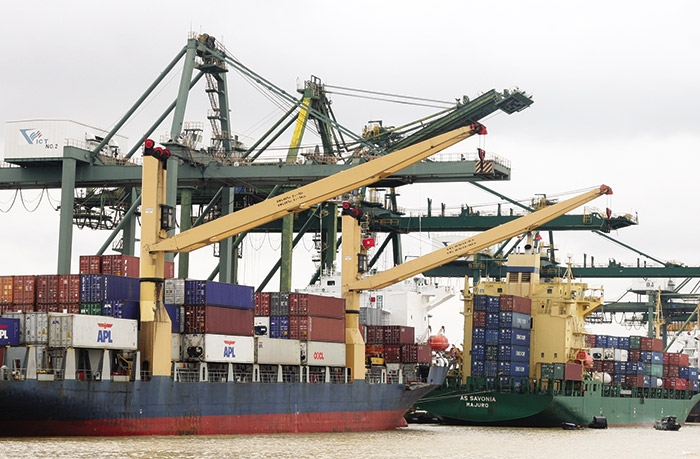Possibilities wide open in CPTPP era
 |
| The CPTPP deal means Vietnam will have greater access to 10 other major economies, Photo: Le Toan |
According to the World Bank’s freshly-updated survey on key impacts of the CPTPP on the Vietnamese economy, the country will be one of the top beneficiaries from the deal following its entry into force on December 31, 2018.
Based on simulated results, the bank stated that in terms of output, by 2030 Vietnam’s GDP is estimated to be 1.1 per cent higher, compared with 0.4 per cent higher under the Regional Comprehensive Economic Partnership (RCEP), and 3.6 per cent higher under the TPP-12 (which included the US) with respect to baseline economic conditions.
“Assuming a modest boost to productivity, the estimated increase of GDP would amount to 3.5 per cent from the CPTPP, compared with 6.6 per cent for the TPP-12 and 1 per cent from the RCEP,” the survey said.
As for exports and imports, under the deal, Vietnam’s exports are projected to grow by 4.2 per cent, and imports by 5.3 per cent, with larger increases of 6.9 and 7.6 per cent, respectively, assuming productivity gains.
In addition, exports from Vietnam will also benefit from the deal. The average trade-weighted tariffs faced by Vietnamese exporters to CPTPP markets will fall from 1.7 to 0.2 per cent. Non-tariff measures faced by Vietnam in CPTPP markets are expected to decline, on average, 3.6 percentage points in ad-valorem tariff-equivalent terms.
Tran Toan Thang, head of the World Economic Board under the National Centre of Socioeconomic Information and Forecast, told last week’s seminar on Vietnam’s economic outlook that from 2019 the country will enjoy significant benefits via the CPTPP.
“The deal will add $1.7 billion per year to Vietnam, as opposed to $2.7 billion for the TPP-12,” Thang said. “Vietnamese export turnover will also involve another $4.09 billion per year, while import turnover will also add $4.93 billion.”
According to the World Bank, the largest growth in output through the agreement is estimated to be in food, beverage, and tobacco; clothing and leather; and textiles, along with more modest growth in several manufacturing sub-sectors. Export growth is expected to be strongest in food, beverage, and tobacco; clothing and leather; chemical, leather, and plastic products; transport equipment; and machinery and other equipment. Imports are expected to grow in all sectors.
Ngo Tuan Anh from the Economics Faculty of the National Economics University said that based on his studies, garments and textiles, footwear, and aquatic products are now largely exported to Canada, Chile, and Australia, which are members of the CPTPP, and “will continue being boosted in these markets upon the deal’s entry into force.”
“Meanwhile, telephones and computers will have more opportunities to be exported to Malaysia, Indonesia, Singapore, Mexico, and New Zealand,” Tuan Anh said.
Recently, HSBC released a comprehensive survey of global businesses, including 200 from Vietnam, showing that 63 per cent of enterprises in Vietnam believe the CPTPP will have a positive impact on their business.
HSBC Vietnam’s CEO Pham Hong Hai said that with the US not present in the CPTPP, Vietnam’s benefits may be less than originally forecast in the former TPP set-up. For example, GDP will only move up 1.32 per cent instead of 6.7 per cent and exports will increase by 4 per cent instead of 15 per cent. “However, industries like garments and textiles, leather footwear, and labour-intensive ones will still benefit. Vietnam will be able to take advantage from access to member markets, especially those on the other side of the Pacific, such as Canada and Mexico,” Hai said.
What the stars mean:
★ Poor ★ ★ Promising ★★★ Good ★★★★ Very good ★★★★★ Exceptional
 Tag:
Tag:
Related Contents
Latest News
More News
- Vietnam eases policy approval requirements, simplifies foreign and outbound investments (December 11, 2025 | 17:53)
- Unpacking new momentum in Vietnam’s M&A market (December 10, 2025 | 09:59)
- Forum honours outstanding M&A deals, strategies, and advisory firms (December 09, 2025 | 18:22)
- Vietnam enters defining phase of M&A growth (December 09, 2025 | 17:00)
- Vietnam’s M&A market opens new opportunities amid strong economic momentum (December 09, 2025 | 15:00)
- Vietnam M&A Forum 2025: new position, new momentum (December 09, 2025 | 14:30)
- FDI in Vietnam jumps on additional capital and share purchases (December 09, 2025 | 13:56)
- VIR gathers dealmakers for M&A forum (December 08, 2025 | 17:17)
- Vietnam steps up green transformation with strong policies and rising investment demand (December 06, 2025 | 12:07)
- Listed companies honoured for information transparency (December 06, 2025 | 11:59)
























 Mobile Version
Mobile Version